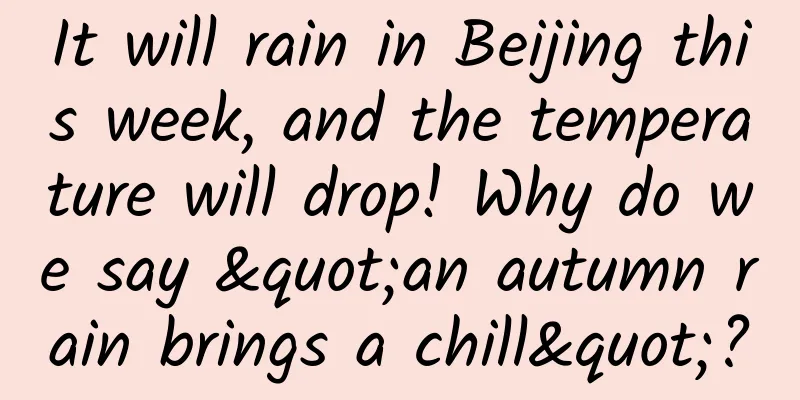It will rain in Beijing this week, and the temperature will drop! Why do we say "an autumn rain brings a chill"?

|
Review expert: Ye Haiying, deputy director of the New Media Center of the Meteorological Publicity and Science Popularization Center of the China Meteorological Administration (China Meteorological News Agency) Recently, Beijing has had several consecutive rains, ending the previous period of high temperatures and sweeping away the previous hot and stuffy feeling, making people feel the coolness of autumn. So the question is, why are rain and temperature drop so closely related in autumn? There is a proverb that goes, "One autumn rain brings one cold day." This is a valuable experience drawn by the ancients through years of observation. This means that the temperature will gradually drop after entering autumn, and each autumn rain will be colder than the last. Usually there is another saying behind it, "Ten autumn rains will make you wear cotton." After a few autumn rains, you can wear winter clothes. What is the scientific basis behind this saying? 0 1 Weakening of solar radiation After the summer solstice, the sun's direct point gradually moves southward toward the Tropic of Capricorn, and the sun's rays to the northern hemisphere continue to tilt. At this time, the intensity of solar radiation weakens and the number of daylight hours decreases. This not only causes the ground to receive less and less heat, but also intensifies the ground's own radiation cooling, gradually moving towards a state where heat input is insufficient to meet output. The figure shows the movement law of the sun's direct point Moreover, the higher the latitude, the more obvious the shortage of heat. Therefore, the thicker the cold air accumulates in high latitudes, the more frequent the southward movement of cold air masses, and the southward movement of cold air masses becomes inevitable. This is the most fundamental reason for the cold weather after each autumn rain. The picture shows the Earth's revolution 0 2 Cold air moves southward and causes rainfall The transport of colder air towards warmer air, that is, air blowing from cold areas to warm areas, is called cold advection. It often causes the temperature in warmer areas to drop and is one of the factors that cause drastic weather changes. After entering autumn, a cold air mass moves southward from Siberia and Mongolia and encounters warm and humid air from the south. The interface between the cold and warm air masses clashes and interacts, resulting in rainfall. During the day, clouds block the sunlight and "cold rain" falls from high altitude, causing a more drastic drop in temperature. 0 3 Intensification of radiative cooling When rainfall occurs during the day and causes a drop in temperature, the cooling process continues at night as the clouds disperse. The role of clouds in affecting temperature is like a quilt we use to keep warm. On the one hand, clouds can absorb the long-wave radiation from the ground, and on the other hand, they return the radiation from the ground itself to the ground, emitting long-wave radiation to the ground - atmospheric back radiation. The arrival of cold air will make the air in the area dry and cold, and the air layer will be more stable. When the relevant area is controlled by the cold air mass from the north, the weather will clear at night and the ground will lose its cloud cover. This will result in the ground radiation heat dissipation not being blocked, and of course, there will no longer be back radiation from the clouds to the ground. The southward movement of the sun's direct point causes the ground to gradually receive less heat, and coupled with the ground's own radiation cooling, the ground temperature will become lower and lower. This silent cooling process that occurs at night often causes the temperature to reach the extreme minimum value for the same period. From this point of view, the temperature drop caused by rain is just an appearance. Cold advection plus strong radiation cooling on the ground are the main reasons why people feel that the air near the ground becomes colder with each autumn rain. 0 4Cold air frequently moves south After the battle between warm air and cold air, the latter will usually lose and slowly retreat to the south. Then, the local area will be controlled by the cold air mass, the weather will clear up, and the temperature will drop. A few days later, when new cold air moves south from Siberia or Mongolia and meets the increasingly weak warm and humid air again over the local area, new rainfall and cooling weather will occur. Cold air activities have a certain regularity. Generally speaking, they move south once every 5 to 7 days on average. Ten autumn rains will take more than two months. After ten autumn rains, you naturally have to wear cotton. So, why doesn’t it cause cold weather when there is so much rain in the summer? In summer, there is plenty of warm and humid air. As long as there is a little cold air, precipitation can form. Even most of the time, precipitation does not require the participation of cold air. The high temperature and strong solar radiation in summer promote the evaporation of water vapor and atmospheric convection. Coupled with the influence of monsoons and tropical cyclones, there is more rainfall in summer. Therefore, if it is not precipitation caused by cold air moving southward, the temperature will not necessarily drop. The weather will gradually get cooler over this period of time, so please keep adding clothes and be careful not to catch a cold! |
<<: Exercising for 1 hour a week equals to earning an extra $170,000 a year?!
Recommend
Qingfeng Xiantan·The first phase of Douyin music account monetization, daily income of 800+ suitable for ordering gameplay
Why did I choose to create a music account? There...
Can neck massage cause cerebral infarction? Doctors remind: These 5 types of people may not need their necks massaged
Arm pain, neck soreness... I'm sure you'v...
The "mountain people" who lived in Dunli 9,000 years ago knew how to "renovate"? !
Recently, the State Administration of Cultural He...
The Ultimate Method for Strategic Planning
In the process of formulating marketing plans or ...
The fighting power of "autumn mosquitoes" is off the charts. Let's have a "mosquito-killing" storm! See the "vicious" flowers
After finally getting through the summer mosquito...
Want to raise this kind of "golden retriever"? Warning: life imprisonment!
Golden Retriever, my dream dog, tall and gentle. ...
Don’t take triglycerides lightly; high levels can be fatal!
《Cotton Swab Medical Science Popularization》 Xu S...
Samsung Note7 global recall does not include Chinese foreign companies' high-priced and low-quality services. When will this end?
Recently, Samsung's flagship model this year,...
GITC 2014: Elites gather to soar to the sky
[[120831]] In recent years, with the support of n...
How to avoid lightning correctly?
Where is it easy to be struck by lightning? How t...
Little Fox's Minimalist Butt Lifting Course
Introduction to Little Fox's Minimalist Butt ...
Relay "Chasing the Sun" Bravely Climbing - Get to Know the Chinese "Artificial Sun" Research Team
General Secretary Xi Jinping emphasized that stre...
World Beauty Day丨The most cost-effective "beauty" method, you may have been doing it wrong
November 7th of each year is World Beauty Day, wh...
China Passenger Car Association: In January 2025, the national passenger car wholesale volume was 2.101 million new energy vehicles, a year-on-year increase of 27.1%
According to the latest data released by Cui Dong...
Bilibili Product Analysis | "Not just to become the 'Chinese YouTube'!"
Bilibili has developed over the past ten years, f...









